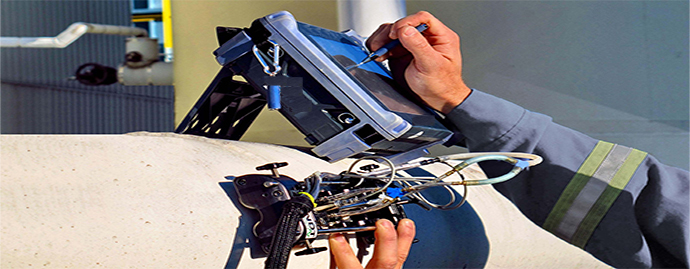| تاريخ البداية | تاريخ النهاية | الدولة | المدينة |
|---|

 +۹٦٦ ۹۲۰۰۰۷۷۷۱
+۹٦٦ ۹۲۰۰۰۷۷۷۱

الأهداف
The trainee will be able to: -
- Safe practice for welding activities and inspection
- Understand the effective points in famous welding process
- How to select the correct welding electrodes for several applications?
- Main feature of some steel and steel alloys and its applications
- Destructive test to evaluate metal properties
- Read and understanding welding map and welding symbols
- Understand welding defects and how to control it
- How to reviewed welding procedures and welder qualifications
- Understand the main deference of codes, standard and specifications and priority of each other
- Monitoring NDT methods to inspect welding joints
الخطوط العريضة
The trainee will be able to: -
- Safe practice for welding activities and inspection
- Understand the effective points in famous welding process
- How to select the correct welding electrodes for several applications?
- Main feature of some steel and steel alloys and its applications
- Destructive test to evaluate metal properties
- Read and understanding welding map and welding symbols
- Understand welding defects and how to control it
- How to reviewed welding procedures and welder qualifications
- Understand the main deference of codes, standard and specifications and priority of each other
- Monitoring NDT methods to inspect welding joints
Materials types
Ferrous
- Carbon Steel types
- Stainless steel types
- Cast iron types
Non ferrous
- Nickel ant its alloy
- Cupper and its alloy
- Material properties
Strengths
Ductility
Hardness
Toughness
DPTT
- Destructive test to determine the material properties
Tensile test
Hardness test
Impact test
- International codes governing material industries and acceptance criteria for each material type such as
- ASTM and API codes
- introduction to welding and its roles in industrial sectors
- safety requirements in welding activities
eye, ear, face and head protection
protection clothes
- welder’s levels (level I level II and level III) according to AWS rules
- introduction to the main welding process
- welding positions (1G ,2G ,3G, 4G,5G,6G,6GR) and how the test occurs
- AWS standard for welding terms and definitions
- shielded metal arc welding (SMAW) process
machine parts
SMAW electrodes and how to read the electrode designation according to AWS designation
Different electrodes type and how to select
Low hydrogen electrode types and Preheat requirements for it
Heat input and the factors affecting it
- Process current
- Voltage
- Travel speed
Heat source in SMAW process and arc fundamentals
Flux as a shielding source in SMAW and its functions
Advantages and limitation for SMAW
Arc blow effect and how to eliminate
- SMAW applications
- Gas metal arc welding (GMAW) process
machine parts
GMAW electrodes and how to read the electrode designation according to AWS designation
Different electrodes type and how to select
Modes of transfers
Different gas types and its advantages and limitation
- Argon
- Helium
- Co2
- Mixed gas
GMAW applications
Advantages and limitation for GMAW
- Flux cored arc welding (FCAW) process
machine parts
FCAW electrodes and how to read the electrode designation according to AWS designation
Different electrodes type and how to select
Different gas types and its advantages and limitation
- Argon
- Helium
- Co2
- Mixed gas
- Self-shielding without using gas
FCAW applications
Advantages and limitation for FCAW
- Gas tungsten arc welding (GTAW) process
machine parts
GTAW electrodes and how to read the electrode designation according to AWS designation
Different electrodes type and how to select
Different gas types and its advantages and limitation
- I1 gas type and its uses
- I2 gas type and its uses
- I3 gas type and its uses
GTAW as a common process in welding stainless steel materials
Injection gases in GTAW and its roles in welding quality
Advantages and limitation for GTAW
- Over view on EBW, ESW, OAW, LW and friction welding
- Submerged arc welding (SAW)
Machine parts
Welding electrodes
Different shielding flux
Uses in fit up sections
W/D ratio and its effect on welding variables
- welding joint geometry& welding symbols and NDE symbols
AWS A3.0 standard welding terms and definitions
AWS A2.4 welding symbols
Joint types
- Butt joint
- Lap joint
- Corner joint
- T – joint
- Edge joint
Applicable weld for each joint type
- Fillet weld
- V-groove weld
- J- groove weld
- Flare bevel grove
- Bevel groove
- Plug, spot, slot seam and braze
- Documents governing welding, inspection and qualifications
Documents types
- Drawing
- Codes
- Standard
- Specifications
- Recommended practices
- ITP
Qualifications
- Welders
- Takers
- WPS & PQR
AWS D1.1 and ASME IX for welder and welding joint qualifications
- P- numbers of different materials
- Essential and non-essential welding variables
- type of DT required for each case and No. of specimens
- Welding defects and hoe to avoid and repair it
Cracks
Under cut
Porosity
Lack of fusion and penetration
Slag inclusion
Cap reinforcement and excessive root
- Over view for NDT methods
VT tools and practical training on using it to measurement welding defects and repot form
PT and MT
RT and practical training for film interpretation
UT and practical training for using thickness measurements tools
من ينبغى أن يحضر
- Welding technicians (welders, fitters, and helpers)
- Welding supervisors
- Material engineers
- Receiving material inspectors
- All site engineers (welding – fabrication- inspection)
- Design engineers
المدة
5 أيام










